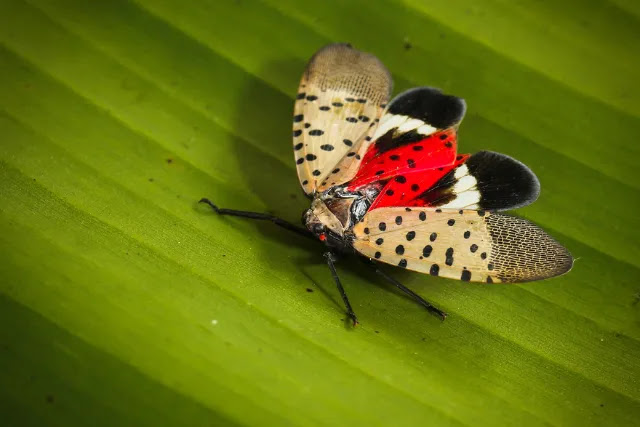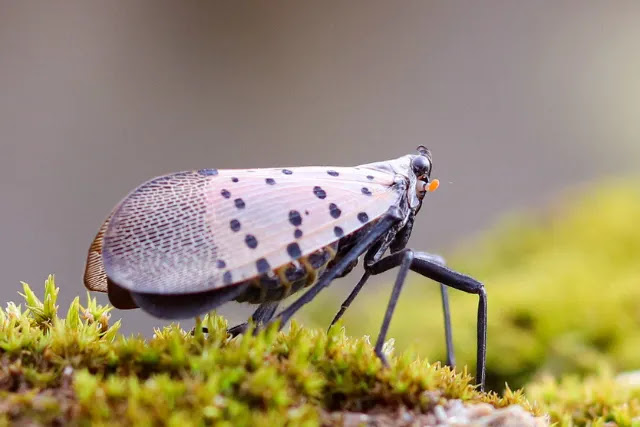Spotted lanternflies do not sting or bite humans, pets, or animals. But they are known to cause major damage to almost any plants they come across, including crops, flowers, fruits, and trees. On top of making a mess in your garden, these invasive species make it difficult to live in a place they have infested.
Yet, there aren't many predators of the spotted lanternflies except for the occasional praying mantis, garden spiders, yellowjackets, and chickens. So, if you have a spotted lanternfly infestation, you must do your part to eliminate the destructive pest effectively. Here is a comprehensive guide on how to make homemade spotted lanternfly spray.
By the end of this guide, you will also learn other steps to effectively get rid of spotted lanternflies and keep them away for good.
{tocify} $title={Table of Contents}
What Are Spotted Lanternflies?
Abbreviated as SLF, the spotted lanternfly is a highly invasive pest that traces its origin back to parts of Asia. It was initially discovered in 2014 in Pennsylvania and has since spread invasively throughout the world. These pests can be moved long distances by people via infested materials and items. They have a big appetite, feeding on a wide variety of plant-based products such as fruits and ornamental/hardwood trees.
Adult spotted lanternflies can grow up to 1 inch long and half-inch wide. They have a snout-like head structure and colorful front wings with a light brown color and black dots. Their hindwings have contrasting red and black spots with a visible white band. SLF typically expose their hindwings when frightened or treated with a pesticide.
You can also identify SLF by their yellow abdomen with black bands – the head and legs are plain black. Although they can fly short distances, spotted lanternflies prefer to hop or jump.
Immature spotted lanternflies (nymphs) are black with beautiful white dots. But as the nymph approaches the adult stage, it develops red dots and small wing pads. These hitchhiking pests can lay their eggs on any surface, including patio furniture, vehicles, and outdoor equipment.
Spotted Lanternfly Life Cycle
Spotted lanternflies go through three life stages, during which their physical appearance significantly transforms from the egg, nymph, and adult.
Adult SLF lay masses of eggs in the fall (September through December). They can lay their yellowish-brown eggs on the smooth surfaces of the host plant or non-host materials like stones, boats, firewood, lawn furniture, and bricks. The egg mass consists of 30-50 eggs covered by a light gray, waxy coating. Older coatings change color to a light tan, comparable to cracked mud.
Adult spotted lanternflies cannot survive the cold winter temperatures. But that's not a problem for these destructive species because their eggs survive the winter, hatching in the spring or early summer. The nymphs go through three instar stages before developing into mature adults.
Unfortunately, SLF feed on plants during all their life stages by sucking sap from the leaves and stems of the host plant. While the nymph stage lasts from July through September, full adults start appearing in late July until December. Though they have wings, adult spotted lanternflies are not excellent fliers. But they are strong jumpers and will hop from one plant to another to feed or escape danger.
Effective Spotted Lanternfly Control
Unfortunately, spotted lanternflies are a threat to plants throughout their entire lifecycle. They can invade in large numbers, causing significant damage to your garden or yard. That's why spotting these invasive pests on your property calls for immediate and effective spotted lanternfly control.
The good news is that there are a variety of SLF control options that can provide effective results.
And the best news is that of these options are multiple DIY approaches that work decently. For instance, you can make a spotted lanternfly trap using repurposed items like plastic milk jugs or a clean peanut butter jar with a tunneling system that allows SLF to crawl and get trapped in the collection system.
SLF traps are better than sticky bands, which occasionally capture birds and other non-target creatures. However, traps are only effective when capturing immature SLF (nymphs) as they climb up the tree to feed. So, if spotted lanternflies are already high up the tree, traps won't help. That brings us to the second and most popular spotted lanternfly control method – homemade spotted lanternfly spray.
Homemade spotted lanternfly sprays offer effective results, killing the invaders soon upon contact. You need to spray the solution directly on the pests to kill them. The best part is that this SLF control method is also safe for use around pets, children, and adults. Here is how to make homemade spotted lanternfly spray.
How to Make Homemade Spotted Lanternfly Spray
Here is a step-by-step guide on how to make homemade spotted lanternfly spray for guaranteed results.
Requirements
- Spray bottle
- 2 cups water
- 2 cups dish soap (any brand)
Instructions
- Mix equal parts water and dish soap in the spray bottle
- Shake to mix homogenously
Usage
- Inspect your property or garden and identify areas with spotted lanternflies
- Spray the treatment directly on the lanternflies. The soapy solution will drown the pests.
- You also want to spray the treatment on spotted lanternfly eggs. Make sure to scrape the egg masses from the tree soon after the treatment.
- You can spray this solution on plants, trees, flowers, shrubs, and other surfaces you've seen or suspect lanternflies.
- Finally, remove the dead lanternflies and clean up the treated surfaces. Dead lanternflies create a sticky substance known as honeydew which causes a destructive sooty mold that stains surfaces. But even more bad news would be that this sticky residue is a rich food source for other insects such as flies and ants.
Other Homemade Lanternfly Sprays
Here are other homemade lanternfly sprays that effectively get rid of these destructive creatures:
Vinegar: Vinegar is a powerful solution that can kill and repel lanternflies. In fact, it is one of the best ways to quickly and effectively control spotted lanternflies. Simply add an adequate amount of white vinegar to a spray bottle and spray the solution directly on the adults. It should kill them instantly upon contact.
Neem Oil: Extracted from the neem tree, neem oil is another effective spotted lanternfly spray. This multipurpose ingredient helps control both fungi and pests in your garden. You can spray neem oil directly on the pests to kill them on contact. Alternatively, you can make neem oil traps and leave them around suspected areas/plants.
Essential Oils: Essential oils are another effective solution for killing lanternfly bugs on contact. You can mix a few drops of peppermint essential oil, tree oil, or lavender oil with water and spray the treatment directly on the bugs to kill them instantly. The smell emitted by essential oils is too strong for spotted lanternflies and other nuisance bugs to survive.
Diatomaceous Earth: Pests do not have to eat diatomaceous earth in order to die. This natural insecticide works by drying out the insect's body or dehydrating them to death. Simply mix four tablespoons of diatomaceous earth with a gallon of water, shake to mix well, and spray it on the pests. It provides excellent results by killing lanternflies and lanternfly eggs.
Rubbing Alcohol: Rubbing alcohol is another non-chemical solution to get rid of lanternflies. This solution is powerful enough to kill the spotted lanternflies upon contact. Spray directly on the pest for the best results.
What Attracts Spotted Lanternflies to My Garden?
Spotted lanternflies survive by sucking the life out of many plant species. They feed on the sap of various economically important plants, and if the population is widespread, they can cause extensive damage and significant losses.
Spotted lantern flies can feed on more than 60 species of plants. But they tend to strongly prefer the Tree of Heaven (Ailanthus Altissima), grapevines, blueberries, willow, black walnut, maple trees, birch, and vegetables.
It's important to note that lanternfly preference keeps changing based on the life stage. For instance, nymphs prefer the Tree of Heaven, apples, cherries, plums, maple, willow, grapevine, and pine. On the other hand, adult spotted lanternflies are highly attracted to specific trees such as willow and the Tree of Heaven.
These bugs are also attracted to common Milkweed, which contains toxic chemicals that are lethal to pests - but spotted lanternflies don't know that. So, you can use their ignorance to your advantage by planting many milkweed plants to keep the lanternflies population in check. The poisonous sap causes weakness, confusion, seizures, increased heart rhythm, and eventual insect death.
Final Thoughts
Lanternflies are harmless to humans and animals as they do not have a stinging mechanism. However, these invasive bugs can become a real headache for garden and yard owners.
They cause severe damage to important plants, often resulting in significant losses. On top of damaging your crops, spotted lanternflies excrete a sticky substance known as honeydew, which attracts other pests while encouraging the growth of unsightly sooty mold.
The methods discussed in this guide on how to make homemade spotted lanternfly spray are effective and safe to use around children and pets. If you're not up to the DIY approach, the best thing to do is engage professional pest controllers.




I like to tape them to bottle rockets. Woosh, then Pow!
ReplyDeleteHaha, that's certainly a creative approach! But for those looking for a less explosive solution, the DIY recipe in this article should do the trick.
Delete